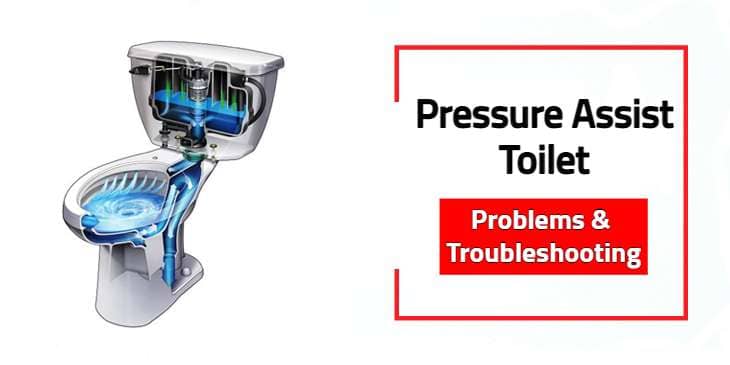After the widespread use of pressure-assist toilets in commercial setups (offices, factories, etc.), they have taken the general consumer market by storm.
With superb efficiency and low-water requirements, they are widely adopted residentially. However, pressure assist toilet problems need to be addressed as well.
Before we dive into the problems of pressure-assist toilets, let’s learn how they work. The key difference between this one and its counterpart (gravity-flow toilet) is the presence of an extra tank.
The air pressure that is present between the two tanks is tremendously strong. When you flush the toilet, the compressed air is set free, and it teams up with gravity, creating an explosive downward force that clears everything up.
Fix Your Pressure Assist Toilet Problems NOW
What sort of problem can a toilet with such a simple mechanism have? Well, some issues are nothing new and the same as gravity-flow toilets. We will look at a few problems of pressure-assist toilets and see whether we can troubleshoot them or not.
Low Water Pressure
Slow flushing is a common problem in gravity-flow toilets, and it also occurs in pressure assist ones. We have seen earlier that these toilets operate by generating a strong flush with the help of air pressure.
The pressure it can generate is dependent on the pressure level (psi) of your residential water supply.
If the pressure level is below 45 psi (pound per square inch), the pressure-assist toilet will give you a slow flush since it cannot generate the required pressure.
Pressure assist toilet troubleshooting is not so different from traditional plumbing. If you check and find out that the water supply is below 45 psi, you can try to fix it by adjusting the pressure-reducing valve.
Turn the screw clockwise that adjusts the pressure, and do not raise it over 45. Residential pipes cannot withstand more pressure than that.
Water Intake Obstruction
When the water inlet of the pressure assist toilet is obstructed, it causes a slow flush with dirty water. If you don’t get the required water for pressure creation, the flush will not be strong either.
To troubleshoot this issue, remove the existing water from the bowl and bring out the water intake screen. Use a brush to clean it up and assemble the toilet back together.
Clogged Air Inducer Valve
There is a tiny hole in the air inducer, which is used to draw air inside the tank of a pressure-assist toilet.
The valve that controls the open or closed state of this hole can get dirty and clogged up with many sorts of debris. This clog can stop the flow of air inside the tank, which will eventually weaken the flushing process.
To solve this problem, turn off the water supply and unscrew the air inducer valve to pull it out. Gently squeeze the valve under a continuous water flow.
Make use of an old toothbrush to clear out the dirt. Reinstall the air inducer valve and turn on the water supply.
Loud Noise
Since a pressure-assist toilet utilizes an explosive flushing technique, being noisy is just a byproduct. However, people who do not like loud noises often find the sound of the powerful flush appalling.
There is no work around for this issue. You can put the cover of the toilet down, and it might lower the noise a bit.
Low Availability of Parts
Since pressure-assist toilets’ working principle is entirely different from gravity-flow toilets, it uses many intricate parts that are not present in the latter one.
Also, many components are sophisticated, and if you are not careful while cleaning them, you might damage the parts.
Hardware stores in your locality might not have the spare parts needed to repair a pressure-assist toilet. You might need to directly contact the vendor you bought it from, which is often an inconvenience.
Risk of Explosion
Around a hundred cases have been reported in the United States on exploding pressure-assist toilets. Since these toilets rely on strong air pressure, there is a chance that the tank might explode due to malfunctioning parts.
The structure of a pressure-assist toilet is formed by many tiny components that can become faulty without you noticing.
If you have a pressure-assist toilet at your home, please check-up regularly and keep the tank and valves clean. No one wants to see their toilets blow up!
Pressure Assist Toilet Flush Good or Bad?
Pressure assist toilets are known for their powerful flush, but opinions on their quality can vary. Some people consider them to be an improvement over traditional gravity toilets, as they can effectively remove waste with less water usage. This can save water and reduce the likelihood of clogs. However, others find that the pressure-assisted flush can be too forceful and create noise, which can be unpleasant. Additionally, pressure assist toilets are more complex than gravity toilets and may require more maintenance or repair.
Ultimately, whether a pressure assist toilet is good or bad depends on individual preferences and priorities. There are lots of toilet flushing systems available in the market, If you are looking for a toilet that uses less water and flushes effectively, a pressure assist toilet might be a good choice for you. However, if you prefer a quieter and simpler toilet, a traditional gravity toilet might be a better option.
Final Words
A pressure-assist toilet is guaranteed to save water while ensuring a maximum cleaning flush.
However, it is not free from issues of its own, and we have tried to bring forth a few pressure assist toilet problems and what you can do to troubleshoot them.
If you notice even the smallest deformity in any parts of your pressure assist toilet, take care of it, and if needed, replace it.
